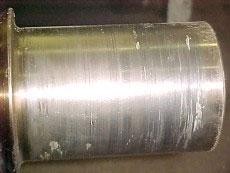Contributing Writer
- FMA
- The Fabricator
- FABTECH
- Canadian Metalworking
Categories
- Additive Manufacturing
- Aluminum Welding
- Arc Welding
- Assembly and Joining
- Automation and Robotics
- Bending and Forming
- Consumables
- Cutting and Weld Prep
- Electric Vehicles
- En Español
- Finishing
- Hydroforming
- Laser Cutting
- Laser Welding
- Machining
- Manufacturing Software
- Materials Handling
- Metals/Materials
- Oxyfuel Cutting
- Plasma Cutting
- Power Tools
- Punching and Other Holemaking
- Roll Forming
- Safety
- Sawing
- Shearing
- Shop Management
- Testing and Measuring
- Tube and Pipe Fabrication
- Tube and Pipe Production
- Waterjet Cutting
Industry Directory
Webcasts
Podcasts
FAB 40
Advertise
Subscribe
Account Login
Search
Salvaging damaged shafts
- By Elia Levi
- January 15, 2008
- Article
- Arc Welding
Shafts are important, highly stressed mechanical elements used to transmit rotary motion from a driver unit to a driven part. Like any other component, a shaft can fail by one of a series of failure modes.
If the shaft is broken in two or more pieces because of fatigue cracking across most of the section, not much can be done to restore it to a useful part, except possibly in exceptional cases by special means (see example in a later paragraph).
But before you throw a broken shaft in the scrap bin, investigate the failure. An investigation can suggest some minor changes that, if introduced in the new part, will improve performance and lengthen useful life.
Worn or damaged shafts are part of everyday life. A failed shaft can shut down any machine when it is most needed for an urgent job. Whoever is in charge of production probably would go out of his or her way to purchase or steal a replacement part at whatever cost.
If a spare part is not readily available, it might be more expedient to pressure the repair shop and request shaft reconditioning in 24 hours at most.
Considering Repair
Management should provide all available information about the shaft, including the original drawing of the part, to the person in charge of the maintenance and repair facility.
What is the material? What are the treatments and the hardness? Was the part case-hardened? This information is essential if welding is being considered as a possible repair process.
If this information is not available, it would be wise to seek the help of a metallurgical laboratory before planning the repair procedure. An informative, qualitative analysis of the material can be easily obtained nondestructively by X-ray fluorescence, a commonly used test also available with portable equipment. Having some knowledge about the material's hardness helps to anticipate the kind of problems likely to arise when attempting to weld the material.
Welding Considerations
Shafts commonly are made of hard steel. Welding procedures can affect repairs in many ways. High-alloy steel is prone to cracking when welded, unless special procedures, such as preheating, are put in place.
The welding heat reduces the hardness and strength of the original material, but may promote the formation of a very hard layer in the heat-affected zone, the region bordering the weld.
Furthermore, the uneven heating may produce difficult-to-manage distortions, so it may be preferable to introduce a mechanical joint that restores the function of the shaft, at least temporarily, until a new part is procured.
In principle, weld repair should be attempted only on annealed material that will be hardened again by heat treatment after welding in the usual way.
Restoring Dimensions
Restoring dimensions in a worn shaft is an easier task. Although overlaying with fused powder or copper alloys can be done with an oxyacetylene flame, without melting the shaft material, the process still softens the steel.
Plasma thermal spray is the preferred method, because the shaft material is heated minimally. This is a special process, though, and should be outsourced to an experienced job shop if the skill sets are not available in-house.
A Special Welding Repair
An example of an exceptional case hinted at previously is that of the main shaft of an aircraft gas turbine. Manufacturers found that these expensive parts had to be scrapped when the splines at the shaft end became worn or deformed.
Special friction welding machines were developed and built to repair these shafts. The worn splined end is cut off and a new section is friction-welded in place. Before being approved, the suitability of this procedure was demonstrated by examinations and tests, as usual with aircraft applications.
About the Author
About the Publication
subscribe now

The Welder, formerly known as Practical Welding Today, is a showcase of the real people who make the products we use and work with every day. This magazine has served the welding community in North America well for more than 20 years.
start your free subscription- Stay connected from anywhere

Easily access valuable industry resources now with full access to the digital edition of The Fabricator.

Easily access valuable industry resources now with full access to the digital edition of The Welder.

Easily access valuable industry resources now with full access to the digital edition of The Tube and Pipe Journal.
- Podcasting
- Podcast:
- The Fabricator Podcast
- Published:
- 04/16/2024
- Running Time:
- 63:29
In this episode of The Fabricator Podcast, Caleb Chamberlain, co-founder and CEO of OSH Cut, discusses his company’s...
- Trending Articles
Sheffield Forgemasters makes global leap in welding technology

Welding student from Utah to represent the U.S. at WorldSkills 2024

Lincoln Electric announces executive appointments

Lincoln Electric acquires RedViking

Engine-driven welding machines include integrated air compressors

- Industry Events
16th Annual Safety Conference
- April 30 - May 1, 2024
- Elgin,
Pipe and Tube Conference
- May 21 - 22, 2024
- Omaha, NE
World-Class Roll Forming Workshop
- June 5 - 6, 2024
- Louisville, KY
Advanced Laser Application Workshop
- June 25 - 27, 2024
- Novi, MI



























